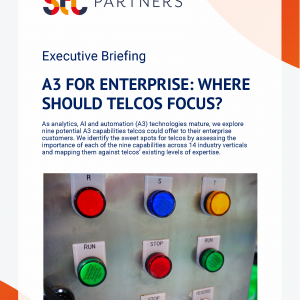Fast-Tracking Operator Plans to Win in the $5bn Location Insights Market
£1,000.00 excl VAT
Drawing insight from the experience of early adopters (including Telefonica, Singtel and DTAG) and exploring the technology options available to operators, we show how operators can best use their distinct advantage over other players in the $5bn location insights marketplace. (October 2015, Foundation 2.0, Executive Briefing Service.)
Description
Format: PDF filePages: 53 pagesCharts: 27Author: Anthony Dornan, Philip LaidlerPublication Date: October 2015
Table of Contents
- Location, Location, Location
- The Importance of Information
- Location Based Services vs. Location Insight Services
- Choosing the Right Strategy
- Where are we now?
- Start with Location Insight Services
- Improve your LIS offering, transition towards LBS & position yourself as a Trusted Data Provider
- Location Insights – Marketplace Overview
- Where is the Opportunity for Location Insight Services?
- Which Sectors are most addressable?
- Sizing the Opportunity
- Why haven’t forecasts developed as quickly as expected?
- Location Insights potentially worth $5bn globally by 2020
- Benchmarks
- Where does the value come from – the Location Insights ‘Stack’
- Understanding the Technology Options
- The Technology Options for Location Data Acquisition
- Technology Advantages for Telcos
- The Right Degree of Location Precision
- Other Advantages of Starting with LIS
- Incremental Learning
- Addressing the Privacy Question
- Market Coverage
- LIS can provide internal benefits and can bolster the Go-to-Market strategy for vertical specific offerings
- Expanding Beyond Insights
- Addressing Location Based Services
- Becoming a Trusted Data Provider
- Practical Guidance to Launch Location Services
- Market Strategy
- Data Management
- An agile approach, partnering, orchestration and governance
- Conclusions
- Appendices
- Appendix 1: Location Acquisition Technologies in Detail
- Appendix 2: Opportunity Sizing Methodology
- Appendix 3: About STL Partners and Telco 2.0: Change the Game
Table of Figures
- Figure 1: Location Insight vs. Location Based Services
- Figure 2: STL Partners’ Analysis of the value of Global Location Insight Services (by 2020)
- Figure 3: Analysis of location data acquisition technologies suitability for Location Insight Services
- Figure 4: The Strategy Beyond Location Insights
- Figure 5: The Explosion of Smartphones (2007-2014)
- Figure 6: ‘Non-Smart’ Data Insights Become More Important as More ‘Things’ are Connected
- Figure 7: Mapping the Telco Opportunity Landscape
- Figure 8: Four opportunity domains for operators
- Figure 9: Turkcell’s Smart Map Tool
- Figure 10: TomTom’s Fusion Engine to Analyze Real-Time Traffic Information
- Figure 11: Tado’s Proximity Based Thermostat
- Figure 12: Expanding Beyond LIS
- Figure 13: Location Insights – Market Taxonomy
- Figure 14: Telefónica Smart Steps Location Analytics Tool
- Figure 15: Motionlogic’s Location Analytics Tool
- Figure 16: The value of Global Location Insight Services by industry and sector (by 2020)
- Figure 17: The Location Insights ‘Stack’
- Figure 18: How well do different location data acquisition technologies support Location Insight Services needs?
- Figure 19: Real-Time vs. Near Real-Time Location Information
- Figure 20: Deveryware’s Dynamic Permissions Tool
- Figure 21: Become a Trusted Data Provider
- Figure 22: Analysis of App/OS based real-time location Technology
- Figure 23: Analysis of App/OS based data stored on device Technology
- Figure 24: Analysis of Emergency Services Location Technology
- Figure 25: Analysis of Granular (building level) network based Technology
- Figure 26: Analysis of Coarse (cell-level) network based Technology
- Figure 27: Analysis of Indoor Technologies
Technologies and industry terms referenced include: Innovation, Insight, Location, Market, model, operator, Strategy, Telco, Telecom, viavi


